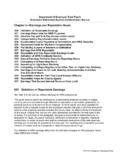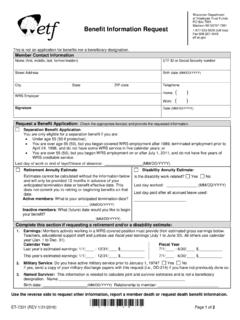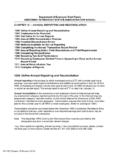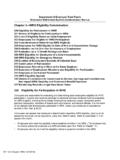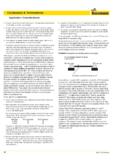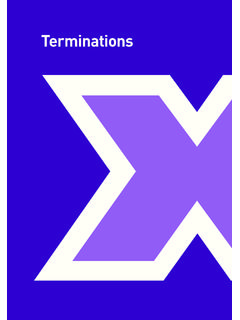Transcription of CHAPTER 14 – TERMINATION RULE AND REPORTING
1 ET-1127 ( CHAPTER 14 REV 5/2/2016)Department of Employee Trust FundsWISCONSIN RETIREMENT SYSTEM ADMINISTRATION MANUALC hapter 14 TERMINATION Rule and Reporting1400 Introduction1401 Minimum Break in Service1402 Required Conditions of a Valid Termination1403 Determining the TERMINATION Date1404 Rehired Annuitants and Valid Terminations1405 Frequently Asked Questions Concerning Valid Terminations1406 Disability TERMINATION Requirements1400 IntroductionFederal law requires a good-faith TERMINATION of employment to qualify for a benefit distribution from a qualified retirement plan such as the WRS. A good-faith TERMINATION from WRS employment has two requirements: Fulfill a Minimum Break in Service Meet All Required Conditions to be a Valid TerminationNote: Some exceptions to Wis. Admin. Code ETF exist when a participating employee is terminating employment due to disability and applying for benefits from either of the disability programs administered by Minimum Break in ServiceIn order to be eligible for a WRS benefit, terminating employees must fulfill a minimum break in service as required by law and rule.
2 The length of the minimum break in service is dependent on the employee s final WRS TERMINATION WRS TERMINATION Date is Prior to July 2, 2013 Employees who terminated WRS-covered employment were ineligible for any benefit (including retirement annuities, lump sum retirement benefits and separation benefits) per Wis. Stat. (1) (a) 1., if they returned to WRS-eligible employment before the latest of the following dates: The annuity effective date. The 31st day after TERMINATION of participating employee s annuity or lump sum benefit was canceled if the return to WRS-eligible employment occured before this required break in service was fulfilled. Any benefit payments received had to be WRS TERMINATION Date is On or After July 2, 2013 Employees who terminate WRS-covered employment are ineligible for any benefit (including retirement annuities, lump sum retirement benefits, and separation benefits) per Wis.
3 Stat. (1) (a) 1., if they return to WRS-eligible employment before the latest of the following dates: The annuity effective date. The 76th day after TERMINATION of participating ( CHAPTER 14 REV 5/2/2016)Wisconsin Retirement System CHAPTER 14 TERMINATION Rule and ReportingThe employee s annuity or lump sum benefit will be canceled if the return to WRS-eligible employment occurs before the required break in service is fulfilled. Any benefit payments received will have to be Adm. Code ETF (2) (a) provides that No person may receive any retirement annuity, separation benefit or lump sum payment from the Wisconsin retirement system without first terminating from his or her current participating employment with all participating Note: Refer to subchapter 1505 on Waiver of Part-time Local Elected Official for Required Conditions of a Valid TerminationWis.
4 Admin. Code ETF defines the conditions a TERMINATION must meet to qualify for a WRS benefit. There are some exceptions for terminations when an employee is applying for WRS administered disability benefits, as described in subchapter 1504. ETF reserves the right to investigate any TERMINATION (or subsequent hiring of a WRS annuitant) when it appears there was not a good-faith TERMINATION . A valid TERMINATION meets all of the following conditions: 1. The employee ceases to render compensable : Compensable refers not only to wages, but also includes contributions to a section 457, 403(b), 401(k), or any other Internal Revenue Code retirement savings account as well as any other item of The employee and employer comply with the employer s policies for voluntary TERMINATION , including the filing of a letter of As of the TERMINATION date, the employer has no rights to any future services to be rendered by the employee that meet the qualifications for WRS coverage for which compensation has or will be paid.
5 Note: This restriction includes emeritus programs where compensation in any form is a condition for future services. Entering into an emeritus agreement with a retiring employee prior to their TERMINATION , regardless of the number of future work hours expected, may violate ETF and result in TERMINATION of the employee s WRS benefit. No agreement for future services can be entered into prior to the employee s TERMINATION . School districts or other employers seeking to establish such programs need to wait until after the employee terminates before entering into such agreements. This means the rule: Prohibits an agreement as of the TERMINATION date for any future WRS compensable employment with the same WRS employer, regardless of whether that employment would meet WRS participation standards. Prohibits an agreement as of the TERMINATION date for future employment with a different WRS employer that would meet WRS participation standards.
6 Note: Contracts or agreements for WRS employment entered into during the minimum break in service period bring into question whether the TERMINATION was done in good faith. To ensure compliance with section 401(a) of the federal Internal Revenue Code (IRC), ETF may investigate situations where it appears a contract or agreement was entered into during the minimum break in service ( CHAPTER 14 REV 5/2/2016)Wisconsin Retirement System CHAPTER 14 TERMINATION Rule and Reporting4. The employee is treated consistently with the status of a former employee. 5. The terminated employee has no authority to act as a representative of the employer or exercise any authority/control over employees of the employer, except as provided above. For example, Emeritus professors could render services for the university after TERMINATION on the condition that they do not receive any form of compensation, including employer contributions to IRC s.
7 403 (b) The employer has paid the employee any accumulated benefits that are customarily paid to employees at the time of : These conditions do not prohibit an agreement as of the TERMINATION date for future employment with a different WRS employer that does not meet WRS participation standards or prohibit an agreement prior to TERMINATION for purely voluntary future services for which no compensation has been or will be paid. 1403 Determining the TERMINATION DateThe TERMINATION rule provides criteria for determining the TERMINATION date. The date reported to ETF should be the earliest of: The date an unpaid leave of absence expires when an employee fails to return to work following the leave. The date three years after an unpaid leave of absence began, except for military leave or union service leave. The date on which the employer discharges the employee.
8 The date the employer determines that the employment relationship terminates. Note: The effective date of the TERMINATION can not be earlier than the date the employer notifies the employee of the TERMINATION . The last date for which the employee receives earnings for personal services rendered to, or on behalf of, the employer, unless the employer has granted an unpaid leave of absence for a period after this date. Note: Teachers employed under a 9-10 month contract may be considered terminated as of the last day they are required to perform district related work rather than the last day of the contract s fiscal year. The date the employee s voluntary resignation is effective as accepted by the employer or, if later, the date the employer receives the employee s notice of resignation. Retroactive resignation is not permissible. The date of the employee s death.
9 Refer to Chapters 9 and 10 for instructions on REPORTING ( CHAPTER 14 REV 5/2/2016)Wisconsin Retirement System CHAPTER 14 TERMINATION Rule and Reporting1404 Rehired Annuitants and Valid TerminationsIn order for an employee to receive a WRS benefit (including retirement annuities, lump sum retirement benefits, and separation benefits) and return to WRS eligible employment, the two requirements of a good-faith TERMINATION must be met: Fulfill a minimum break in service as outlined in subchapter 1401. Meet all valid TERMINATION conditions as outlined in subchapter the minimum break in service or any TERMINATION requirement is not met, the TERMINATION is not in good faith and the member is potentially ineligible for their or agreements for WRS employment entered into during the minimum break in service period bring into question whether the TERMINATION was done in good faith.
10 To ensure compliance with federal IRC 401(a), ETF may investigate situations where a contract or agreement was entered into during the minimum break in service may also investigate the TERMINATION of any WRS employee to ensure compliance with federal IRC 401 (a). During an investigation, the burden of demonstrating that a TERMINATION was done in good faith and met all TERMINATION requirements will fall on the employer and employee. Should ETF determine that the conditions of a good-faith TERMINATION were not met, the WRS benefit will be considered invalid and need to be repaid. The consequences of this decision have the following effect on the employer and employee: Any retirement benefit would be considered paid in error. If an annuitant is receiving a monthly retirement benefit, the monthly payments will be discontinued and ETF will collect any monthly payments paid in error.

